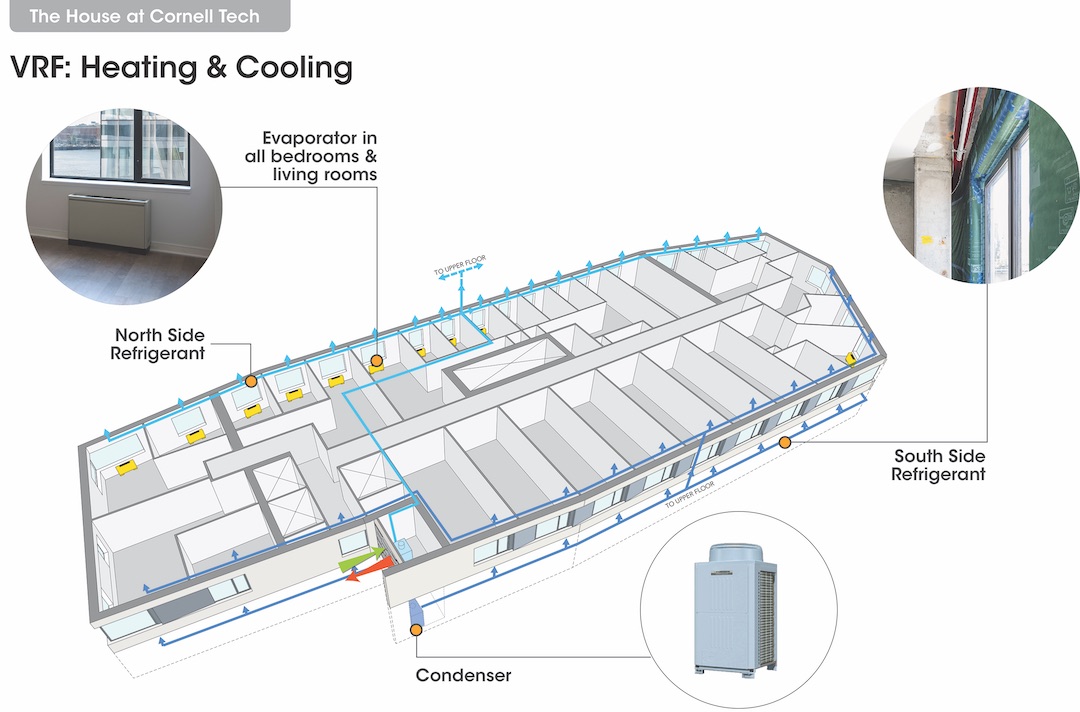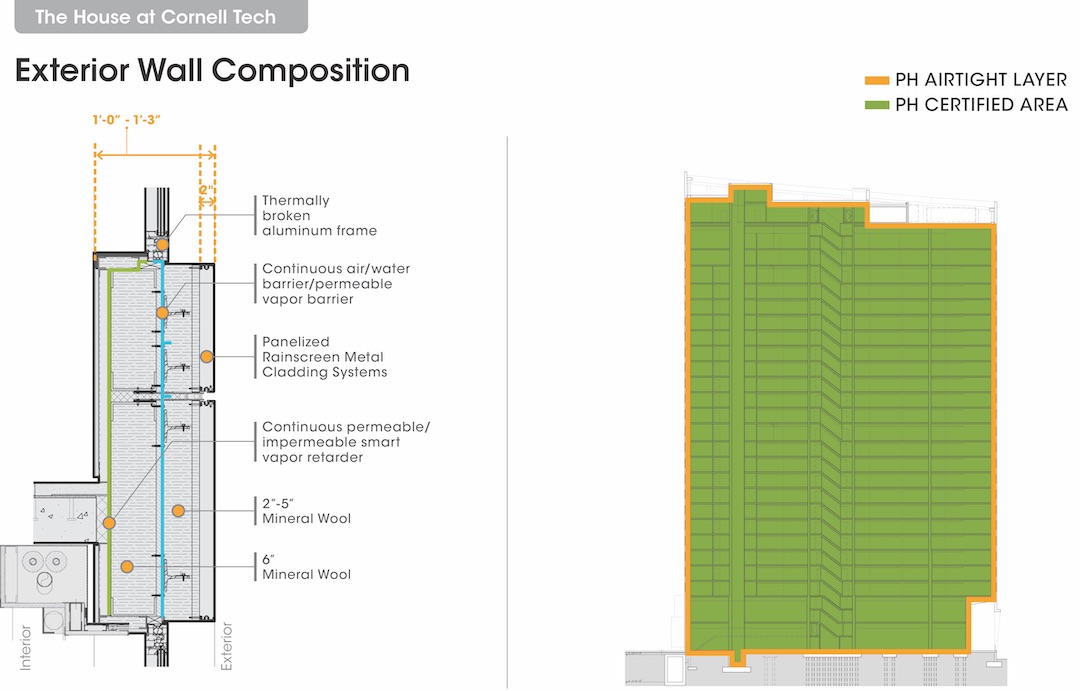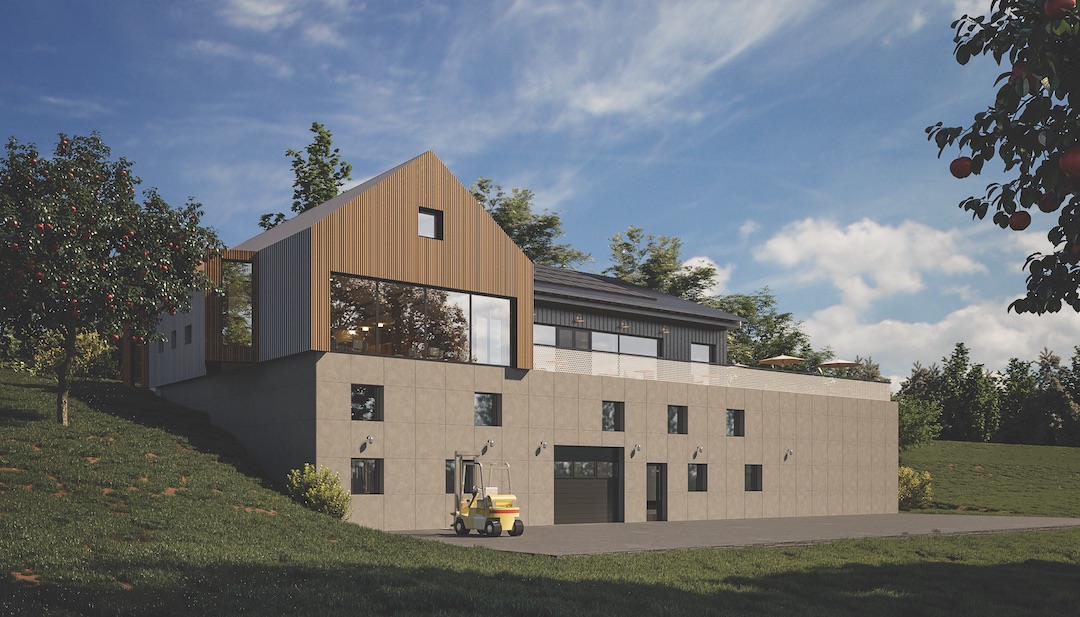Millennium Partners is in the process of building Winthrop Center, a $1.35 billion mixed-use tower in Boston’s Financial District that, when completed in 2022, will have more than 1.8 million sf of residential, office, and retail space that will pursue LEED Platinum certification. Its 20 floors of office space—which Handel Architects designed in collaboration with MIT’s Metabolic Design Office—are being taken one step further to meet the Passive House Institute’s rigorous standards for energy efficiency.
“We have no hesitation applying Passive House standards to other building types,” says Deborah Moelis, Principal and Passive House designer with Handel Architects.
The firm’s recent work includes The House at Cornell Tech on Roosevelt Island in New York City, a residential tower that, at 270 feet tall and 272,000 sf, is the largest and tallest building in the U.S. to earn Passive House certification. The standard encourages extreme energy efficiency in buildings through passive design measures, such as an airtight envelope, continuous insulation, heat and moisture recovery ventilation, and minimal space conditioning.
The concept of a “passive” structure that requires little energy to provide satisfactory occupant comfort levels has been around since the 1970s. Germany-based Passive House Institute—whose standards were applied to the Winthrop Center and House at Cornell Tech projects—dates back to 1996. Chicago-based Passive House Institute US (PHIUS) can trace its roots back to 2003. It released its PHIUS+ standard in March 2015, and refined that standard three years later to make it even more climate-specific and cost-sensitive.
“The institute realized that it made less sense to try and save that last inch of energy rather than come up with something that could be applied across the country,” explains Michael Knezovich, a spokesman for PHIUS.
Passive House standards have been applied to the construction of hundreds of residential structures in North America. However, the standard is still looking for its way into the commercial, institutional, and multifamily building sectors. “It’s doable, but it’s more of a one-off,” acknowledges Knezovich.
See Also: Timber grows up
What’s holding back Passive House from having a bigger commercial impact are its low energy use targets. “Energy consumption is driven by the building’s process, and reducing the process side is the hardest part,” says James Hartford, AIA, LEED AP BD+C, CPHC, a Partner with River Architects in Cold Spring, N.Y., which started building to Passive House standards in 2012 and has four associates (including himself) who are certified Passive House consultants.
Other AEC firms believe, however, that standards that dictate lower energy use in commercial buildings could become the norm, as cities like Boston, Chicago, New York, and Seattle update their codes to require that buildings meet certain CO2 emission levels or, in some markets, face stiff fines.
“We’re going to have to design for equipment that runs on extremely low power, and design buildings differently,” predicts Moelis.
Tom Bassett-Dilley, who owns an eponymous architectural firm in Oak Park, Ill., built the first Passive House in the Chicago area, in 2012. He notes that PHIUS+ 2018, which takes into account local climates as well as the density and occupancy of the building, might be more amenable to commercial construction. His firm is currently designing a 45-unit apartment building in Oak Park to pass Passive House muster. He uses energy optimization software, known as BEopt, to measure a building’s energy performance.
Bassett-Dilley estimates that building to Passive House standards adds 5-10% to construction cost. But the result “leads to significant savings on energy” over the life of the building. “Any project is a statement on value,” he says.
Passive House also “dovetails” with a much bigger industry trend toward electrification to reduce combustion in projects by specifying heat pumps, variable refrigerant flow (VRF) systems, and electric water heaters, observes Julie Janiski, CHPC, LEED AP, Principal of Integrated Design with BuroHappold Engineering, which was on the building team for The House at Cornell Tech.
Subsidies spur construction
Illinois’ Clean Energy Foundation requires that any project seeking grant money must first submit its plans to PHIUS for evaluation. The foundation recently awarded $577,800 to the Park District of Oak Park, Ill., to add 3,000 sf of classroom space built to Passive House standards onto an existing building known as Carroll Center, which is used for preschool-aged classes and after-school programs.
Chris Lindgren, the district’s Superintendent of Parks and Planning, says that originally the older building—which dates back to the 1920s—was going to be torn down. But when the district’s board decided to save it, a board member suggested that geothermal be installed. By tapping the Clean Energy Foundation for grant money, “we were able to do more,” says Lindgren.
 This illustration depicts the variable refrigerant flow system design at The House at Cornell Tech in New York City, the largest and tallest building in the U.S. to earn Passive House certification. Image: Handel Architects.
This illustration depicts the variable refrigerant flow system design at The House at Cornell Tech in New York City, the largest and tallest building in the U.S. to earn Passive House certification. Image: Handel Architects.
He says it was “a relative snap” to build the addition to Passive House standards. But upgrading the older building required a complete gut, deepening the wall cavities for extra insulation, adding six inches of insulation to the basement floor, and installing triple-pane windows. The addition and reconstruction cost $1.7 million. The Carroll Center’s grand reopening is scheduled for this June.
In Callicoon, N.Y., about 90 miles from New York City, Doug Doetsch, who owns the Orchard at Seminary Hill, is using a $900,000 economic development grant from the state to build a $2 million, two-story, 8,600-sf organic cider mill production facility, the first of its kind to pursue PHIUS certification. The key building components include insulated concrete forms, SIPs panels on heavy timber framing, high-performance windows and doors, with continuous insulation, air barriers, and weather barriers.
Harford of River Architects, the mill’s designer, says that, in essence, this is two Passive House buildings, because of the separate temperature zones for apple storage on the lower floor (50 F to 55 F), and the tasting and event space on the upper floor (68 F).
The mill should be completed next fall. River Architects has other Passive House projects under way, including the conversion of Bethel, N.Y.’s town hall to office space, and the renovation of a school in Brooklyn under the auspices of the New York School Construction Authority.
It’s all in the façade
The most ambitious building to date in the U.S. that is meeting extreme energy efficiency criteria remains The House at Cornell Tech, a 26-story tower housing 352 apartments. BuroHappold states that this project’s primary challenge was reducing the building’s energy consumption by between 60% and 70% in a market whose average seasonal temperatures range from 23 F to 86 F.
Moelis of Handel Architects recalls that none of the building team members had any previous experience building to Passive House standards. The team got much-needed guidance from Lois Arena of Steven Winter Associates, the project’s sustainability consultant, and Luke Falk, a Vice President with the Related Companies’ Hudson Yards Technology.
 The House at Cornell Tech is one of the most ambitious buildings to be constructed to meet extreme energy efficiency standards. It achieved that with, among other things, an airtight envelope whose façade includes 11 inches of insulation, six inches of which is in the stud cavity. Image: Handel Architects.
The House at Cornell Tech is one of the most ambitious buildings to be constructed to meet extreme energy efficiency standards. It achieved that with, among other things, an airtight envelope whose façade includes 11 inches of insulation, six inches of which is in the stud cavity. Image: Handel Architects.
Designing to Passive House standards hinges on the façade engineering. Eastern Exterior Wall Systems fabricated the metal panelized wall units for The House at Cornell Tech with 11 inches of insulation, six inches of which was in the stud cavity; thermal breaks in the wall so heat and cold didn’t seep into the building; and an airtight envelope, says Kenneth Loush, Eastern’s Chief Engineer.
Schuco-brand windows were shop-installed into the panels, accounting for only 23% of the façade’s surface area, says Janiski of BuroHappold. While that worked fine for The House at Cornell Tech because its rooms are small, Janiski acknowledges that keeping the window-to-wall ratio low is a tough sell to developers that are “attracted to glass.” But it’s imperative, she adds, to avoid paying a premium to get triple-pane glass to perform as expected.
The House at Cornell Tech has been a springboard for BuroHappold to consider building other projects to Passive House standards. “It makes you go back to basics,” says Janiski.
Editor's Note: Additional information about PHIUS and Passive House Institute in Germany were included after this article was initially posted.
Related Stories
| Jan 21, 2011
Sustainable history center exhibits Fort Ticonderoga’s storied past
Fort Ticonderoga, in Ticonderoga, N.Y., along Lake Champlain, dates to 1755 and was the site of battles in the French and Indian War and the American Revolution. The new $20.8 million, 15,000-sf Deborah Clarke Mars Education Center pays homage to the French magasin du Roi (the King’s warehouse) at the fort.
| Jan 21, 2011
Virginia community college completes LEED Silver science building
The new 60,000-sf science building at John Tyler Community College in Midlothian, Va., just earned LEED Silver, the first facility in the Commonwealth’s community college system to earn this recognition. The facility, designed by Burt Hill with Gilbane Building Co. as construction manager, houses an entire floor of laboratory classrooms, plus a new library, student lounge, and bookstore.
| Jan 20, 2011
Construction begins on second St. Louis community center
O’Fallon Park Recreation Complex in St. Louis, designed by local architecture/engineering firm KAI Design & Build, will feature an indoor aquatic park with interactive water play features, a lazy river, water slides, laps lanes, and an outdoor spray and multiuse pool.
| Jan 20, 2011
Community college to prepare next-gen Homeland Security personnel
The College of DuPage, Glen Ellyn, Ill., began work on the Homeland Security Education Center, which will prepare future emergency personnel to tackle terrorist attacks and disasters. The $25 million, 61,100-sf building’s centerpiece will be an immersive interior street lab for urban response simulations.
| Jan 19, 2011
Extended stay hotel aims to provide comfort of home
Housing development company Campus Apartments broke ground on a new extended stay hotel that will serve the medical and academic facilities in Philadelphia’s University City, including the University of Pennsylvania and the Children’s Hospital of Philadelphia. The 11,000-sf hotel will operate under Hilton’s Homewood Suites brand, with 136 suites with full kitchens and dining and work areas. A part of the city’s EnergyWorks loan program, the project aims for LEED with a green roof, low-flow fixtures, and onsite stormwater management. Local firms Alesker & Dundon Architects and GC L.F. Driscoll Co. complete the Building Team.
| Jan 19, 2011
New Fort Hood hospital will replace aging medical center
The Army Corps of Engineers selected London-based Balfour Beatty and St. Louis-based McCarthy to provide design-build services for the Fort Hood Replacement Hospital in Texas, a $503 million, 944,000-sf complex partially funded by the American Recovery and Reinvestment Act. The firm plans to use BIM for the project, which will include outpatient clinics, an ambulance garage, a central utility plant, and three parking structures. Texas firms HKS Architects and Wingler & Sharp will participate as design partners. The project seeks LEED Gold.
| Jan 19, 2011
Museum design integrates Greek history and architecture
Construction is under way in Chicago on the National Hellenic Museum, the nation’s first museum devoted to Greek history and culture. RTKL designed the 40,000-sf limestone and glass building to include such historic references as the covered walkway of classical architecture and the natural wood accents of Byzantine monasteries. The museum will include a research library and oral history center, plus a 3,600-sf rooftop terrace featuring three gardens. The project seeks LEED Silver.
| Jan 19, 2011
U.S. Green Building Council Welcomes New Board Directors
The U.S. Green Building Council (USGBC) has announced newly elected officers and new directors to its 2011 Board of Directors, including Elizabeth J. Heider from Skanska; Kirsten Ritchi from Gensler; and Dennis Maloskey, from the Pennsylvania Governor's Green Government Council.
| Jan 10, 2011
Michael J. Alter, president of The Alter Group: ‘There’s a significant pent-up demand for projects’
Michael J. Alter, president of The Alter Group, a national corporate real estate development firm headquartered in Skokie, Ill., on the growth of urban centers, project financing, and what clients are saying about sustainability.














